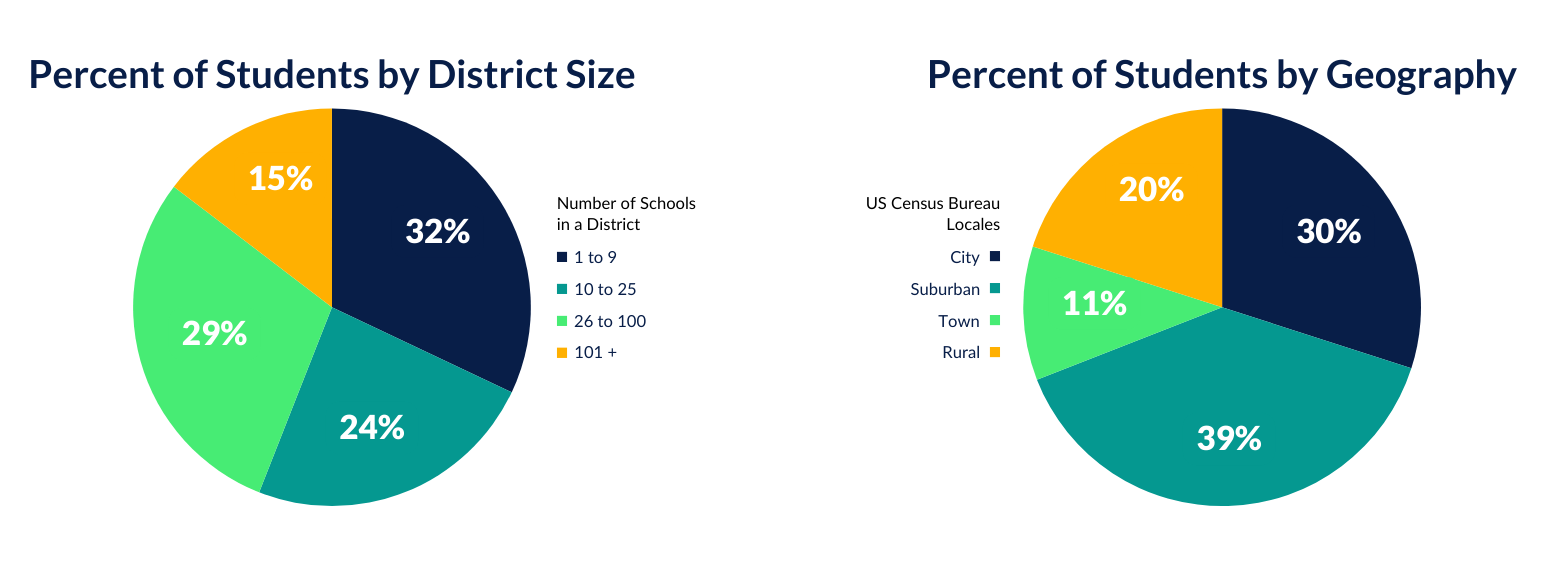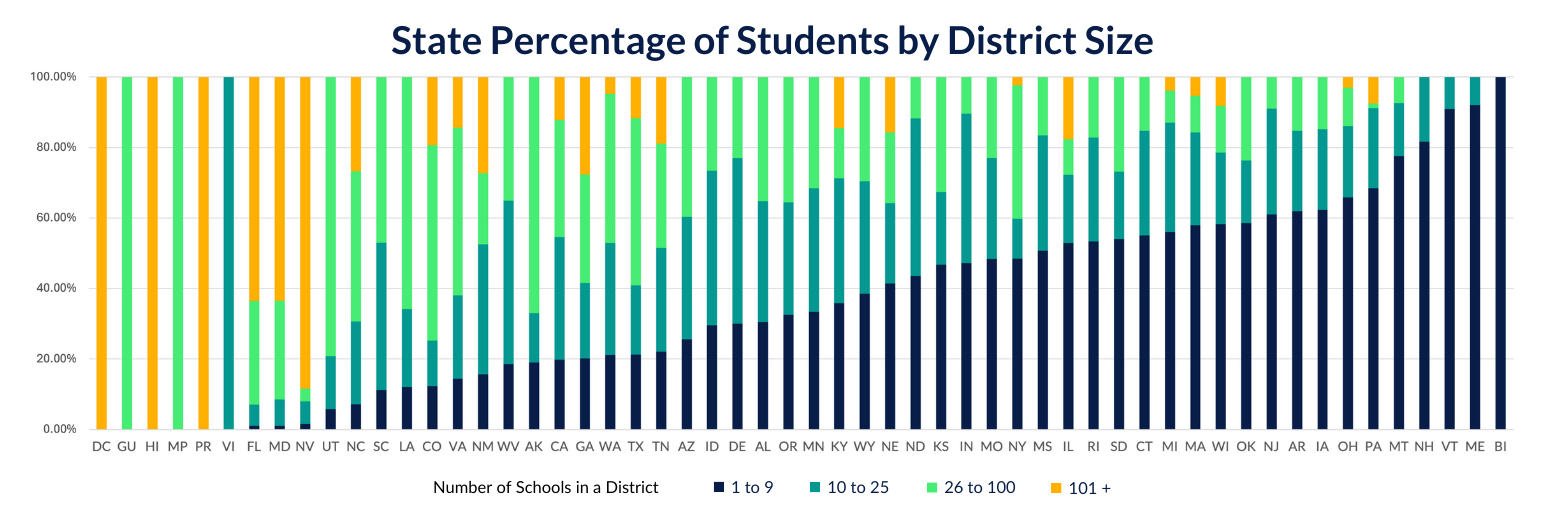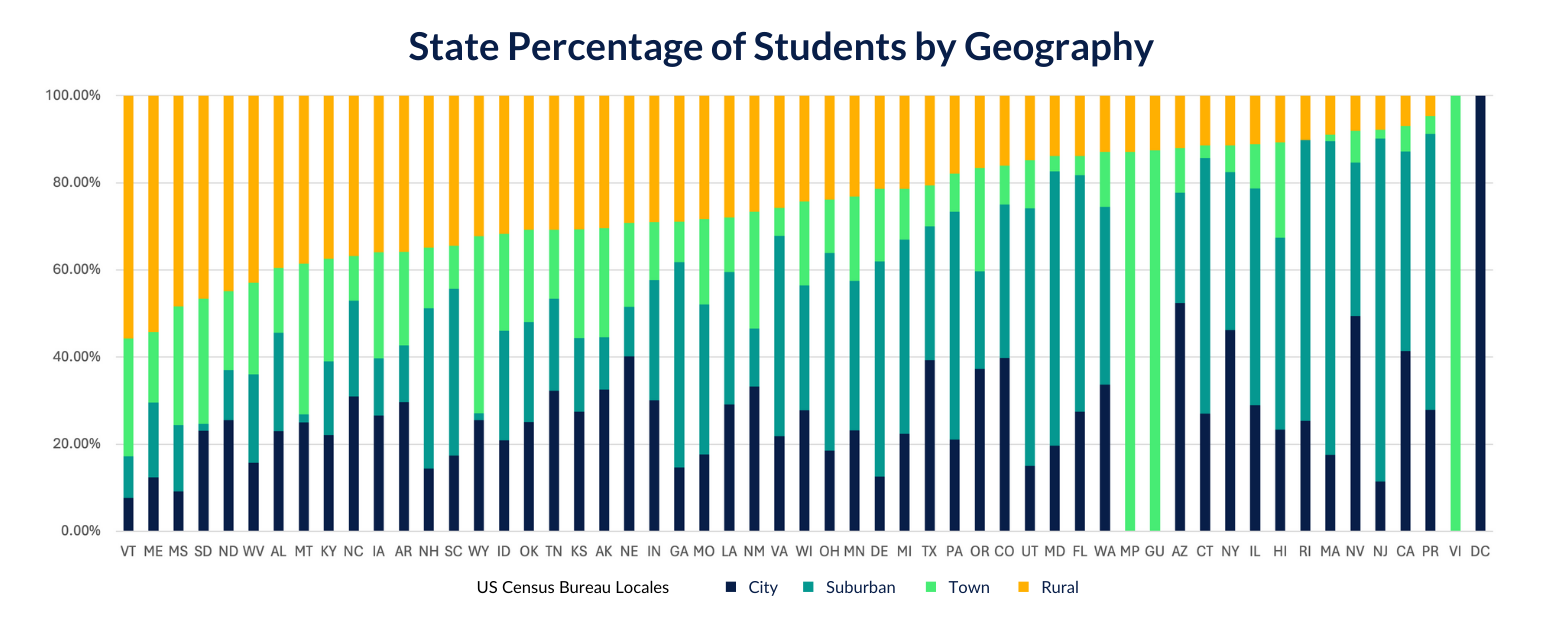States and state agencies have been taking important steps to understand and support the educator pipeline through funding innovations such as residencies and Grow Your Own programs to setting policies for preparation programs and licensure.
There remain, however, some low-cost, high-value interventions where state agencies (or regional service centers) can play an important role in improving educator pipelines—the key is not just focus on the volume of the flow of preservice teachers into schools, but also consider how they are distributed and how successful they are.
When it comes to accessing and leveraging the flow of preservice educators (practicum, student teachers, residents, etc.) into hiring pipelines, district needs differ by many factors, but two critical ones are district size and geography.
Here are the national pictures of the percentage of students broken down by the number of schools in their district (note 1) and locale type (note 2):

Smaller (and more rural) districts often have limited access to a pipeline of preservice teachers and to relationships with Educator Prep Programs (EPPs).
Larger districts typically have more volume of preservice teachers but frequently under leverage placements by matching based on minimal criteria (licensure and grade level), partly because of the logistical difficulty of managing more nuanced information at scale.
Across all sizes and geographies, cultivating a large enough pool of available mentors to be able to match intentionally is challenging.

But regardless of context, the result is missed opportunities for better-matched placements within districts and across regions. Research (note 3) demonstrates that better-matched placements yield:
Increased student performance from new teachers
More confident first-year teachers
Higher retention of new teachers
The flow of preservice pipelines across a state or region impacts the costs of hiring, retention, and ultimately student achievement. Here are some of the factors that matter:
Distribution Matters: Student teachers tend to stay in the district of their placement
Alignment Matters: Placements similar to teaching positions (grade level, class type, and student demographics) improve new teacher confidence, performance, and retention
Quality Mentors Matter: High-quality mentors dramatically accelerate the professional development of student teachers
Stability Matters: Reducing the number teacher movements (between grade levels, schools, and districts) by getting to the right fit sooner improves student outcomes and lowers costs (note 4)
What can State Agencies do?
1. Gather information. We know that EPPs and Districts work together to different degrees to make a wide variety of preservice placements, but that most processes face challenges and miss opportunities (note 5). Collect facts on what is happening in your state which will give you a sense of the scope and scale of opportunities to strengthen your educator pipelines.
You will want to learn from districts:
Which have placements of each type and how many?
Which EPPs they take placements from or work with to place?
What does the process look like?
You will want to learn from EPPs
Which programs in each make placements and how?
Which LEAs are their partners?
What does the process look like?
Torace offers states and regional service centers a FREE tool for gathering this information and understanding this landscape.
2. Look at this information against the backdrop of your state or region’s landscape based on district size and geography. Here are breakdowns based on percent of students served to get you started thinking:


3. Start SMALL!: Once you have the lay of the land you can then understand the particular complexities of your context as well as where there are the most missed opportunities. You can then run a low-cost pilot targeting either a collection of smaller districts (Example A below) or a larger district (Example B below)—or one of each!
If you think your agency might be interested in FREE information gathering or potentially piloting a differentiated approach to support, schedule a call with one of Torace’s Co-Founders to learn more. In addition to our free data collection and landscape analysis tool, we can also provide support around
Pilot design and stakeholder engagement
Implementation and using the Torace Platform
Fully outsourced pilot programming
Example A
Starting Place to Support Smaller and More Remote Districts: Mentor Pipelines
States or regional service centers can help to cultivate a pipeline of potential mentor teachers across a network of smaller or more rural districts. Torace can be used to gather teacher data around teacher interest and readiness, and we can provide low-cost, light-touch training and opportunities to connect teachers informally with others across networks of institutions to build leadership and mentoring skills.
Benefits:
Create a “bench” of potential mentors and their interests who could be tapped for activities like:
Informational interviews with preservice teachers interested in smaller or more remote environments
Buddy mentor for new teachers in another location
Future cooperating teachers
Connect institutions and educators to one another to build community
Understanding the strengths and professional development needs of teacher leaders and future teacher leaders in your smaller and more remote locations can inform policy and other initiatives
Example B
Starting Place to Support Larger Districts: Facilitating Logistics for Districts and EPPs
When it comes to placement processes, matchmaking in most large systems is driven mostly by one side of the relationship—District or EPP—though both need to have some role/commitment in the process. In this dynamic, however, there are missed opportunities when, in the flow of information about mentors and preservice teachers to whomever is making the matches, logistical hurdles must be overcome or an insufficient pool of mentors exists. One of the primary reasons that institutions maintain the status quo around placement processes, is that the true “cost” of the systems that make minimal matches (e.g. reduced retention, lower performance) is rarely seen as linked to matching.
States can support larger districts and their EPP partners by making the benefits of change visible, by providing access to scalable tools, and by collecting and sharing data to refine research and best practices.
Your initial data gathering will have provided you with a short list of districts suitable for a pilot, or you may need to narrow your list. A district is more likely to make a good candidate for a case study in low-cost, high-value transformation if it meets the following criteria:
Currently making high volume of matches themselves (as opposed their EPP making the matches)
Using minimal information on preservice educators to make placements (primarily licensure area and grade level)
Can be working with one or more prep programs
Has goals around improving recruitment, hiring, retention of educators in strategic plan
Has goals around improving student outcomes in strategic plan
Once you have identified your pilot partner, connect them with Torace to explore tools and options for implementation support. Districts willing to participate in case studies and research will receive the first-year subscription to the tool at no cost and additional implementation help.
Notes:
Data source: https://nces.ed.gov/ccd/data/zip/ccd_lea_029_2223_w_1a_083023.zip LEAs were limited to “regular public schools” with one or more open schools.
Data taken from: https://data-nces.opendata.arcgis.com/datasets/nces::public-school-characteristics-2021-22/about Locale Definitions: https://nces.ed.gov/programs/edge/docs/LOCALE_CLASSIFICATIONS.pdf
More information on details and sources can be found at: https://torace.com/article/big-picture-potential
For more details about topic of logistical complexity and matching processes, see our summary report on one representative district: https://app.hubspot.com/documents/20417099/view/663580146?accessId=c63481
If you would like a downloadable copy of the How Diverse are the Needs of Your State? infographic, click here.

